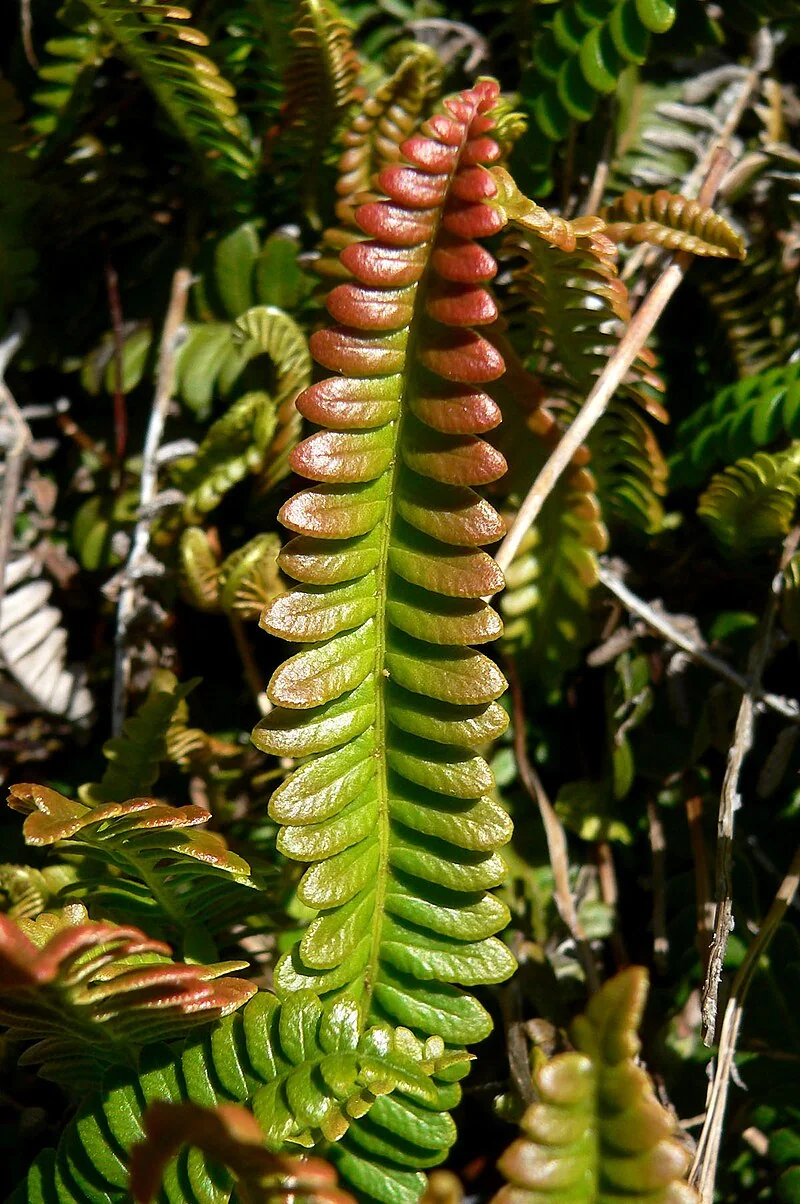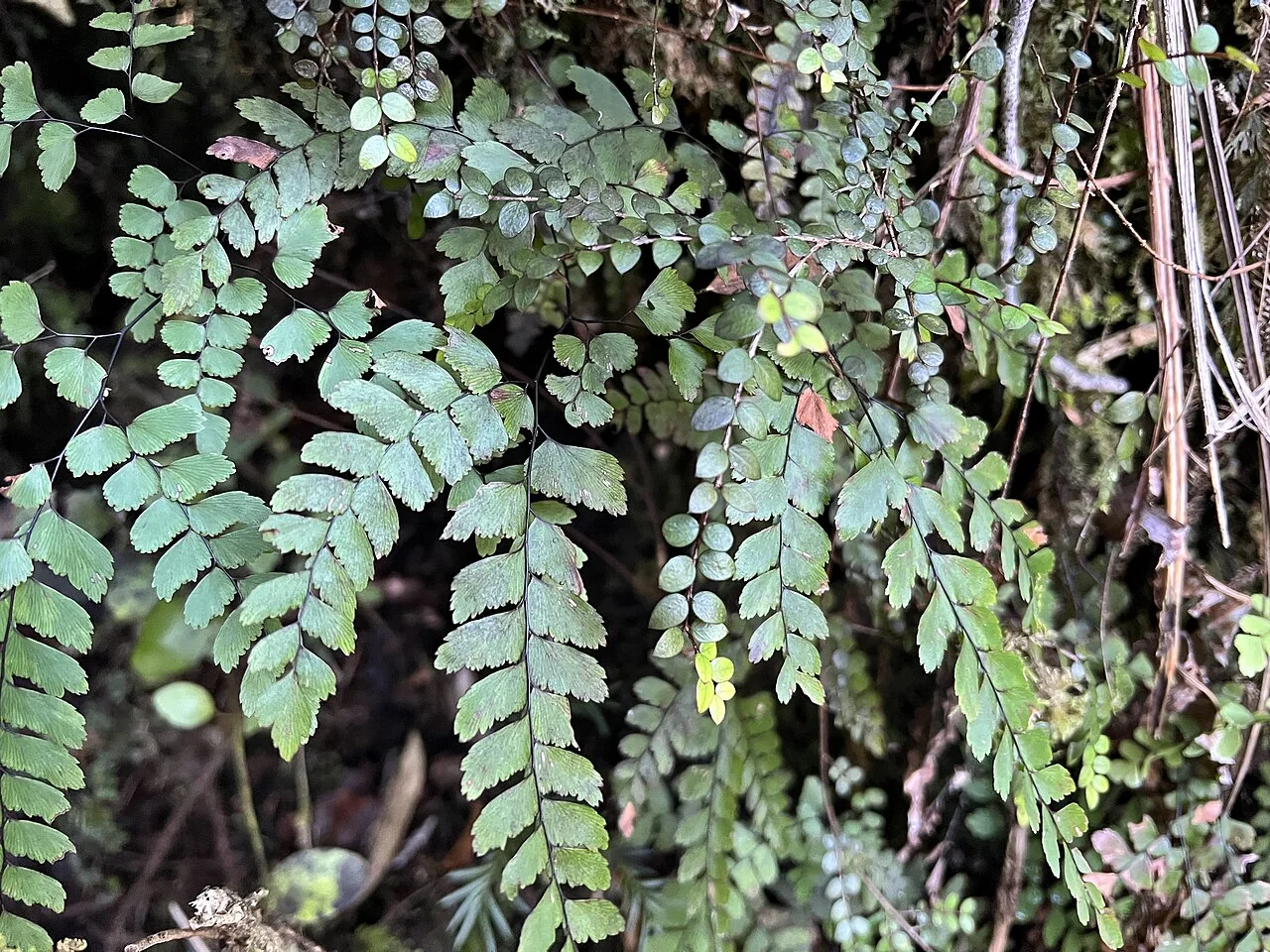
Alpine Water Fern
Austroblechnum penna-marina
Austroblechnum penna-marina , also known by common names such as Antarctic hard-fern, Little Hard Fern, Alpine Hard Fern, alpine water fern, and pinque, is a species of evergreen fern belonging to the family Blechnaceae. It is a widely distributed fern in the Southern Hemisphere, found naturally in New Zealand, Australia, and South America, including various sub-Antarctic islands. This fern is characterized by its wiry rhizomes and exhibits strong dimorphism in its fronds, meaning it has two distinct types of fronds: sterile and fertile. The sterile fronds are typically prostrate or semi-erect, growing up to 400 mm in length. They have a yellow-brown stem and feature 12-44 pairs of triangular or oblong pinnae. When they emerge, they can be a deep salmon colour, darkening to a glossy, rich green. The fertile fronds are longer and held erect, often reaching up to twice the length of the sterile fronds. ferns .

Plant Description
Austroblechnum penna-marina (alpine water fern; syn. Blechnum penna-marina ) is a dwarf, creeping fern forming dense mats. Fronds 5-20 cm, with distinct narrower fertile fronds rising above the sterile frond carpet.
Quick Facts
| Scientific Name | Austroblechnum Penna Marina |
|---|---|
| Common Name | Antarctic hard-fern, Little Hard Fern, Alpine Hard Fern, Alpine water fern, Pinque |
| Plant Type | Evergreen fern |
| Height | 10-20 cm (4-8 inches) |
| Spread | Slowly spreading via rhizomes, forms dense mats |
| Water Needs | Moist to evenly moist; dislikes drought |
| Light | Bright shade to sun in cool climates |
| Rhizomes | Wiry, spreads slowly underground |
| Fronds | Dimorphic (sterile and fertile); sterile prostrate/semi-erect, up to 400 mm, yellow-brown stem, 12-44 pairs of triangular/oblong pinnae, deep salmon to glossy dark green; fertile longer, erect, purplish-black stipe, 10-36 pairs of linear/narrowly oblong pinnae |
| Habitat | Diverse, from coastal to alpine regions (up to 1900 m), open forest, subalpine scrub, grasslands, alpine herbfields, moss fields on shaded rock outcrops |
| Distribution | Southern Hemisphere (New Zealand, Australia, South America, sub-Antarctic islands) |
| Frost Tolerance | Very hardy, tolerates frost and temperatures down to -25°C |
| Salt Tolerance | Low to moderate |
| Growth Rate | Slow to moderate spreading |
| Lifespan | Long-lived perennial |
| Cultivation | Excellent evergreen groundcover, prefers acidic, well-draining, moist soils, tolerates shade or almost full sun with sufficient water, hardy to -25°C |
Climate Best Suited to
Cool temperate to alpine; tolerates frost and light snow with protection from winter wet. In lowlands, prefers cool, moist shade.
Regional Suitability
| City | Climate Suitability |
|---|---|
| Whangārei | Ideal |
| Auckland | Ideal |
| Hamilton | Ideal |
| Tauranga | Ideal |
| Rotorua | Ideal |
| Gisborne | Ideal |
| New Plymouth | Ideal |
| Napier | Ideal |
| Whanganui | Ideal |
| Palmerston North | Ideal |
| Wellington | Ideal |
| Nelson | Ideal |
| Christchurch | Ideal |
| Dunedin | Ideal |
| Invercargill | Ideal |
Natural Habitat
Diverse Environments
Austroblechnum penna-marina (Alpine Hard Fern) has a vast range, from coastal forests to high-alpine herb fields (up to 1900m). It grows in subalpine scrub, grasslands, and on shaded rock outcrops. It is one of the few ferns that thrives in cold, open tussock country as well as under forest canopies.
Plant Conservation
Austroblechnum penna-marina , also known as Antarctic hard-fern, Little Hard Fern, or Alpine Hard Fern, is a widely distributed fern species found across the Southern Hemisphere, including New Zealand, Australia, and South America. The conservation listings lists Austroblechnum penna-marina subsp. alpina as native, but the specific conservation threat category is not stated here; refer to the latest NZTCS for updates.
Growing Requirements
Soil
Adaptable to various soils from peat to loam, provided they remain moist.
Light
Versatile: tolerates full sun (if moist) to deep shade. Grows tighter and redder in sun.
Water
Consistent moisture is key, especially in sunny positions. Tolerates wet feet.
Planting Guide
Best Planting Practices
Plant on raised beds or rock crevices with gritty organic mix; mulch lightly with fine bark or leaf litter to keep rhizomes cool.
Ecology
Groundcover fern stabilising alpine and subalpine soils and providing habitat interstices for invertebrates. Mat-forming growth slows surface runoff, reduces frost heave around shallow roots, and helps retain moisture in exposed, windy sites.
Uses
Excellent evergreen groundcover for cool shade, rock gardens and between stepping stones. Tucks neatly into wall crevices and troughs, softening hard edges while tolerating cold, wet winters where drainage is sharp.
Landscaping Ideas
Carpet beneath alpine shrubs and Chionochloa tussocks; weave among rocks for a natural mountain look. Combine with small hebes and cushion plants to create resilient, low-profile compositions that read well in winter.
Seasonal Care
Summer
Keep cool and moist; provide shade in hot districts. In warm areas, afternoon shade and a cool mulch markedly reduce stress.
Winter
Ensure good drainage to prevent crown rot and avoid water sitting around crowns after snowmelt.
Pruning
Pruning Techniques
Snip away old fronds in late winter to refresh the mat. Avoid scalping - comb gently to remove thatch and keep the carpet even without exposing crowns.
How to Grow Alpine Water Fern
Alpine Water Fern grows best when you match its natural habitat: prepare well-drained soil, get the light right, water steadily, and protect from extremes during establishment. Dig wide planting holes, set the crown at original depth, water to settle, and mulch with coarse organic matter to conserve moisture while keeping the stem base dry. Feed lightly in spring; heavy nitrogen is unnecessary and can weaken growth.
Seed
Sow fresh, viable seed on a free-draining mix, cover lightly with fine grit, and keep evenly moist in bright light out of harsh sun. Germination timing varies; prick out once roots hold the media and harden off gradually.
Division
Where the species permits, divide robust clumps in early spring as new growth begins. Replant divisions with several shoots into fresh mix, water thoroughly, and maintain steady moisture until re"established.
Cuttings
For shrubs and many perennials, strike semi-hardwood cuttings in late spring to summer in a coarse, free-draining propagation mix under gentle bottom heat and high humidity. Reduce leaf area, ventilate progressively as roots develop, and pot on before planting out.
Aftercare
Maintain an open mulch, irrigate during drought in the first season, and prune or tidy according to the species to build a resilient framework. Adjust shade, wind exposure and watering to prevent stress, and refresh mulch annually for long-term performance.
Pests and Diseases
Common Problems and Solutions
Slugs/snails in damp sites; heat stress causes frond scorch - provide shade. Ensure free drainage to prevent winter crown rot, especially in compacted soils.
Cultural Significance
Traditional Uses and Values
Austroblechnum penna-marina , also known by its synonym Blechnum penna-marina , holds some cultural recognition primarily through its various common names across different regions. These names include "Antarctic hard fern," "Little Hard Fern," "Alpine Hard Fern," and "alpine water fern" in English-speaking areas, and "Pinque" in Chilean Spanish. While specific documented traditional cultural significance or uses by Aboriginal people or other indigenous cultures are not readily available, the presence of these names suggests a level of recognition and integration into local knowledge systems.
Bonus Tip
Expert Growing Advice
In warm regions, site on the coolest, shadiest side of rocks with nightly summer irrigation. A thin grit mulch around crowns sheds splash and buffers temperature swings on exposed sites.







